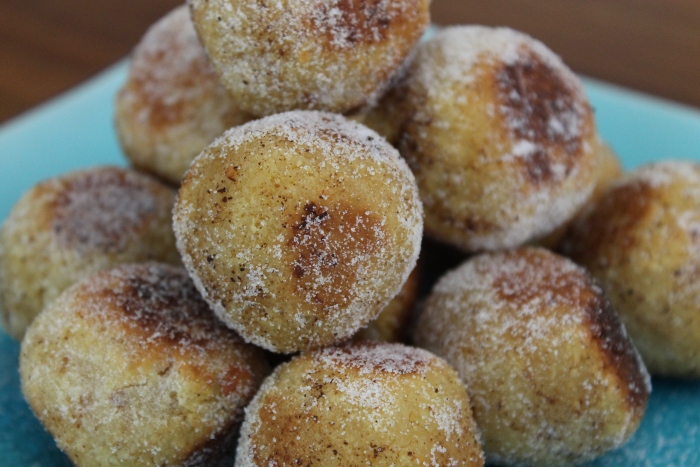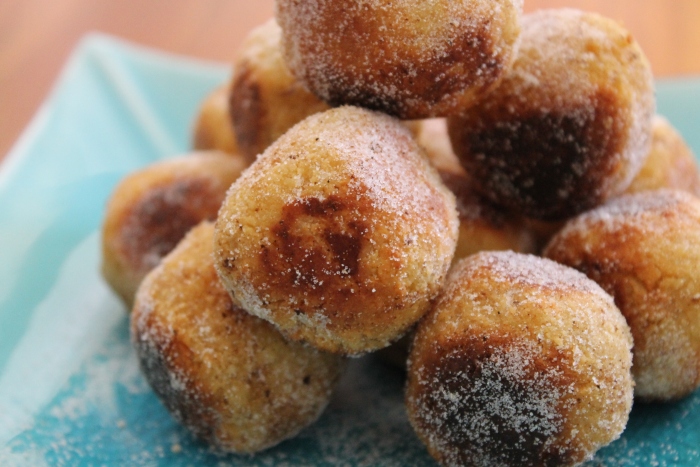This fortnight’s challenge for the Historical Food Fortnightly is ‘Sweets for the Sweet’. For the last little while I’ve been meeting up with a group of fourteenth century reenactors to sew/whittle/cook/relax. One of the questions that has come up is why there aren’t many recipes for cake or biscuits in fourteenth century cookbooks, so when I stumbled across a recipe for ‘emeles’ or almond cakes on the St Thomas Guild blog I knew that I was going to have to try them out.

A page from ADD MS 32085 with a puzzle initial, [Public Domain] via the British Library Illuminated Manuscripts Catalogue
“Emeles. E une friture k’ad a noun emeles. Pernez sucre e sel e alemaundes e payn demeyne, e braez les ensemble; e pus metez des oefs; e pus gresse ou oile ou bure, e pernez une quilere e oingnez les; e pus pernez sus e rose les de sucre sec, &cetera.”[1]
Constance Hieatt and Robin Jones translate this as:
“Emeles [almond cakes]. Here is a fritter which is called emeles. Take sugar, salt, almonds, and white bread, and grind them together; then add eggs; then grease or oil or butter, and take a spoon and brush them [i.e., the emeles, while they are frying] and then remove them and sprinkle them with dry sugar, etc.”[2]

What I think is particularly interesting about this recipe is the way in which it highlights the difficulties of dealing with recipes in Middle English. There are no standardised spellings and the copying of recipes could, and did lead to even more corruptions, especially of foreign words.
Initially Hieatt saw a connection between this recipe, and the recipe for ‘alumelle frite au sucre’ (omelette fried in sugar) in the Menagier de Paris. Later she realised that that the word ‘emeles’ actually comes from the Catalan ‘ametlles’, meaning almonds.[3]
A nearly identical recipe appears in the 14th century Diuersa Cibaria:
“A fritur þat hatte emeles
Nym sucre, salt, & alemauns & bred, & grind am togedre; & soþþen do of ayren. & soþþen nim grece oþur botere oþur oyle, and soþþen nim a dihs, & smeore heom; & soþþen nym bliue, & cose wiþ sucre drue: & þis beoþ þin cyueles in leynten ase in oþur time.”[4]
And again, in the 15th Century Laud MS. 553, although by then the word had been corrupted to ‘cyuele’:
“Nym almandes, Sugur & salt, & payn de mayn, & bray hem in a morter / do therto eyren, frie hit in oylle or in grese, cast theron sugur, & ȝif hit forth.”[5]
Of course, none of these recipes include any idea of the proportions involved. This means that there have been a whole range of different products, all made from the same ingredients. Some are like pancakes and some are like doughnuts while others are more like fritters.
My version are closer to doughnut holes than anything else, and they would be very good with some cinnamon! That being said, they were a bit on the dense side and I didn’t love them. If I was doing them again I might try a higher proportion of almonds to breadcrumbs, a wetter batter, and maybe a different fat to cook them in (I used butter this time).
[1] Hieatt and Jones, “Two Anglo-Norman Culinary Collections Edited from British Library Manuscripts Additional 32085 and Royal 12.C.xii,” 866.
[2] Ibid., 877.
[3] Hieatt, “Making Sense of Medieval Culinary Records: Much Done, But Much More To Do,” 105.
[4] Hieatt and Butler, Curye on Inglysch, 185.
[5] Austin, Two Fifteenth-Century Cookery-Books, 113.

The Redaction
Emeles
150g fresh breadcrumbs (I used sourdough bread with the crusts cut off)
150g almond meal
50g sugar
1/4 tsp salt
2 eggs
Oil/butter/grease to fry
Caster sugar to sprinkle
- Combine the breadcrumbs, almond meal, sugar and salt. Add the eggs and mix well. The batter should be slightly sticky, but thick enough to roll into balls.
- Put the oil, butter or grease in a pan and heat over medium. Roll the batter into balls about the size of a ping-pong ball. Shallow fry the balls in batches, using a spoon or a brush to scoop the cooking fat over the balls. Turn as necessary until golden on all sides. Remove the balls and drain on paper towel.
- Place some caster sugar in a bowl and roll the still warm balls in the sugar until coated. These can be served hot, warm or cold.
The Round-Up
The Recipe: Emeles from Two Anglo-Norman Culinary Collections Edited from British Library Manuscripts Additional 32085 and Royal 12.C.xii by Constance B Hieatt and Robin F Jones (available through JSTOR).
The Date: 1275-1300
How did you make it? See above.
Time to complete?: 30 mins.
How successful was it?: As I said, I didn’t love them because I thought they had a kind of funny taste. That being said, my sewing group enjoyed them and happily ate the rest. The main comment was that they were very dense, and only lightly sweetened (some people thought this was a good thing, others would have liked them to be sweeter).
How accurate?: It’s really impossible to tell, given the myriad ways that the recipe has and can be interpreted. The proportions of the ingredients is one of the big questions, and how to shape and cook them is another. Some people have deep-fried theirs, but I think that shallow frying sounds more likely given the instruction to use a spoon to moisten/brush/anoint them.

Bibliography
Austin, Thomas. Two Fifteenth-Century Cookery-Books : Harleian MS. 279 (ab 1430), & Harl. MS. 4016 (ab. 1450), with Extracts from Ashmole MS. 1439, Laud MS. 553, & Douce MS. 55. London: Published for the Early English Text Society by N.T. Trubner & Co, 1888.
Hieatt, Constance B. “Making Sense of Medieval Culinary Records: Much Done, But Much More To Do.” In FOOD & EATING IN MEDIEVAL EUROPE, edited by Martha Carlin and Joel T. Rosenthal, 101–16. London: The Hambledon Press, 1998.
Hieatt, Constance B., and Sharon Butler, eds. Curye on Inglysch. London: Published for The Early English Text Society by Oxford University Press, 1985.
Hieatt, Constance B., and Robin F. Jones. “Two Anglo-Norman Culinary Collections Edited from British Library Manuscripts Additional 32085 and Royal 12.C.xii.” Speculum 61, no. 4 (1986): 859–82.

Tegan says:
Most deep frying at this time would probably be lard. Butter’s a poor thing to fry in, as it has a low burning point (with the milk solids). You could use clarified butter or ghee if you wanted a more “buttery” taste.
But these are super cool! I like the use of less-perishables like bread and almonds as opposed to flour.
February 26, 2016 — 4:52 am
QNPoohBear says:
Wow! Amazing research and I commend your bravery in trying such an old recipe. They sound pretty good though, if you like almond and a good alternative to doughnuts. I wonder if you could convince my doughnut obsessed 5 year old niece these were doughnut holes and she should try them?
February 29, 2016 — 4:00 am